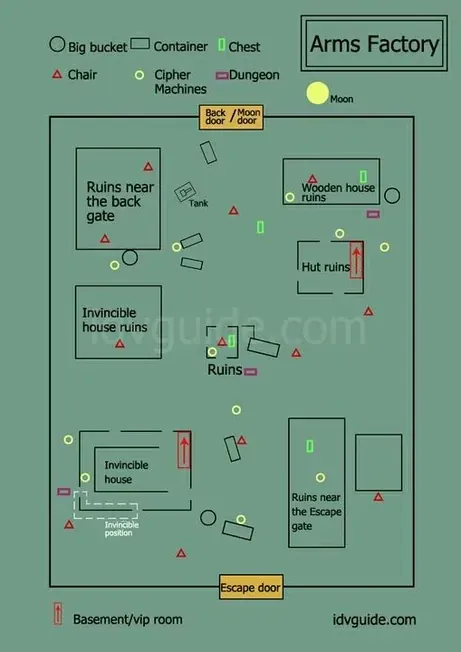Master kiting in Identity V with comprehensive strategies for every hunter. Learn essential movement techniques, hunter-specific counters, and advanced tactics to extend chases beyond 60 seconds while your team completes cipher machines.
Understanding Kiting Fundamentals in Identity V
What is Kiting and Why It Matters
Here's the thing about kiting – it's basically the art of being an absolute pain in the hunter's side for 60+ seconds while your teammates frantically decode cipher machines. Think of it as professional tag, except the stakes are a bit higher.
Each cipher takes 81 seconds to decode from start to finish. That means every second you're dancing around pallets and windows, you're buying precious time for progress. I've watched pro players stretch chases to 90 seconds consistently, and honestly? It's beautiful to watch when done right.
The Terror Radius becomes your best friend here. That heartbeat isn't just atmospheric – it's intel. The intensity changes tell you exactly how close danger is lurking. Most matches run 10-15 minutes, and here's the kicker: hunters get stronger as time goes on through their Presence system. Early-game kiting isn't just helpful – it's absolutely critical.

Basic Movement Controls Setup
Okay, let's talk setup because this matters more than people think. Ditch the auto-camera immediately. Manual camera control gives you awareness that auto simply can't match. Third-person view is non-negotiable for environmental awareness during those heart-stopping moments when you're squeezing through tight spaces.
Sensitivity settings? This is where personal preference meets practicality. You need to balance precision with speed – too high and you'll overshoot, too low and you'll get caught. Spend time in Custom Mode testing different levels before jumping into ranked. Trust me on this one.
For reliable Identity V Echoes recharge online, BitTopup provides instant top-ups with competitive pricing and secure transactions. Their platform ensures quick access to premium content with 24/7 customer support.
Camera and Sensitivity Optimization
Camera positioning is an art form. You want clear sightlines around obstacles while keeping the hunter in your peripheral vision. Here's a pro tip: pause at corners to gauge how committed the hunter is to the chase. Sometimes you can bait an attack just by positioning correctly.
Use that third-person advantage to read hunter animations. Every hunter telegraphs their moves if you know what to look for.
Essential Kiting Mechanics Every Survivor Must Know
Pallet Dropping Techniques

Timing is everything with pallets. Drop them when the hunter is right there – adjacent, breathing down your neck. The stun gives you those precious 10-15 seconds to create distance.
Exception? Hell Ember. Drop early against him to mess with his puppet deployment. Otherwise, resist the urge to panic-drop. I've seen too many survivors waste perfectly good pallets because they got spooked.
Fake drops are your secret weapon. Make the hunter think you're dropping, watch them whiff their attack, then exploit that recovery time. It's psychological warfare at its finest.
Window Vaulting Mastery
Center windows are where mind games happen. Vault to meet the hunter on the opposite side. If they start circling, you've got options – loop the opposite direction or re-vault if they're following through.
Terror Shock avoidance comes down to reading animations. Watch for those fake attacks – hunters love to bait early vaults. Knee Jerk Reflex talent gives you a 30% speed boost for 3 seconds post-vault, but it's got a 40-second cooldown, so use it wisely.
Hitbox Understanding and Positioning
This is where experience really shows. You need to stay close enough to reach pallets and windows but far enough to avoid getting smacked. Zig-zag patterns and irregular movement throw off hunter predictions – predictability kills.
Practice spacing in Custom Mode until it becomes muscle memory. There's no substitute for knowing exactly how close is too close.
Hunter-Specific Kiting Strategies Guide
Kiting Common Hunters
Hell Ember (Difficulty 1-2, D-tier): Honestly, he's more annoying than dangerous. Drop pallets early and focus on breaking line-of-sight to prevent puppet placement. Block his puppet's view whenever possible.

Photographer: This is where team coordination shines. Mechanic's robot can decode in the camera world while you're dealing with the photo copy. Seer shields help coordinate multi-survivor evasion. Just don't commit to abilities when you see that camera world activation coming.
Geisha: Face her directly during the dash animation. Eye contact interrupts her ability and can set up stun opportunities. It feels counterintuitive, but trust the mechanics.
Advanced Hunter Counters
Violinist: His strings are a nightmare, but Perfumer teleports and Priestess portals ignore movement constraints entirely. Forward's stuns disrupt his setup phases beautifully. Keep your team spread – his area control thrives on clustered survivors.
Bloody Queen (S-tier): She's terrifying, but predictable once you understand the mirror mechanics. Change positions constantly to avoid mirror pressure. Use loops and teleports to prevent mirror tracking.
Dream Witch (S-tier): The queen of chaos. Seer owls reveal followers while providing shield protection against multi-attacks. Mechanic robots keep progress going under pressure. Spread positioning minimizes follower effectiveness – clustering against her is suicide.
New 2025 Meta Hunter Adaptations
Season 39 shook things up with 10-15% rescue buffs and 5-10% healing nerfs. This favors active kiting with S-tier survivors over passive healing strategies. Perfumer got some nice teleport range and cooldown buffs that make her even more slippery.
Lanternist drops in October, and early reports suggest some interesting kiting synergies for dynamic map control. We'll see how that develops.
For consistent performance, consider instant Identity V Echoes top up through BitTopup's streamlined platform with competitive rates and instant delivery.
Advanced Kiting Techniques for Pro Players
360° Kiting and Moonwalking
360° kiting involves precise directional changes through circular movement patterns – it's like dancing, but with more adrenaline. Moonwalking combines forward momentum with backward camera angles for truly unpredictable movement.
Chain abilities like Perfumer recall with Flywheel Effect for seamless evasion. When done right, it looks effortless. When done wrong... well, you'll be on a chair pretty quickly.
Tight vs Long Kiting Strategies
Tight kiting uses precise close evasion with frame-perfect timing. It's flashy, effective, and absolutely terrifying for beginners. Safe kiting maintains distance through loops – less exciting, but more forgiving.
The key is knowing when to transition between styles. When resources get exhausted, move to new areas for extended chase duration. Don't be a hero if it means throwing the match.
Transitioning Between Kiting Areas
When pallets run low, transition to open-area patterns. Use Quick Messages to coordinate team support – communication saves lives. Prime final ciphers at 98-99% for Borrowed Time synergy, which provides a 50% speed and healing boost when you need it most.
Environmental transitions break hunter momentum. Sometimes a simple change of scenery resets the entire dynamic of a chase.
Map-Specific Kiting Routes and Terrain Usage
Optimal Routes for Popular Maps
Arms Factory: Compact obstacles, fog, grass, and trees can extend pursuits to 1-2 minutes if you know the routes. Clustered pallets and walls allow for direction faking, while the central factory window creates excellent loop opportunities.

Darkwoods: Vertical play is king here. Trees, platforms, bridges, and the multi-story Hunting Cabin offer escape routes. Swing ropes and ruins provide cover, but avoid that toxic river – it'll slow you down when you can't afford it. The tight cabin layout can extend chases 60-90 seconds easily.
Leo's Memory: Strong pallet distribution, vaultable walls, and stairs at the central factory make this a kiter's paradise. Snowy terrain with barrels and containers provides cover. The Wedding Area features pews and tombstones for creative detours.
Utilizing Environmental Objects
Master obstacle usage by leading hunters to pallets, trees, walls, and crates. Hug corners for stun opportunities. Priestess portals bypass hunter paths entirely and create psychological pressure through unpredictable positioning.
Every map has its secrets. Learn them.
Team Coordination During Kiting Scenarios
Communication Best Practices
Customize those 16 Quick Messages for kiting transitions and cipher progress alerts. Focus on Decoding! and Stay put, I'm coming! coordinate without clustering. Maintain proximity for rescues while avoiding grouping – it's a delicate balance.
Cipher Rush Coordination
Coordinate completion timing for maximum efficiency. 5 out of 7 machines require 6-7 minutes with proper coordination. Prime to 98-99% for Borrowed Time synchronization. Those 3-minute acceleration periods with 30% speed boosts? Use them wisely.
Rescue Kiting Strategies
Execute rescues at Stage 1 (0-49% progress) for 30-second windows. Body block post-rescue on the left side during Tide Turner's 20-second immunity. Limit rescues to maximum 2 per survivor – any more and you're asking for trouble.
Character Selection and Build Optimization
Best Survivors for Kiting
S-Tier Kiters:
Perfumer: Euphoria spray recalls damage 3 times with frame-perfect teleports. She's slippery as an eel and twice as hard to catch.
Priestess: Portal networks for mobility, escapes, and stuns with reduced cooldown. Map control at its finest.
Mercenary: Absorbs 2 hits with 15-second delayed injury, extends chair time 30%. Built like a tank, moves like a dancer.
Antiquarian: Mechanical Flute provides distance and disruption. Underrated but effective.
A-Tier: Forward (rugby stuns that feel incredibly satisfying), Prospector (magnetic stuns work wonders on metal maps).
Persona Web Builds for Movement
'39' Build: Borrowed Time + Knee Jerk Reflex provides 50% endgame boost plus 30% post-vault speed. Solid all-around choice.
'129' Build: Includes Flywheel Effect for 0.5-second immunity dash. Essential for chaining abilities smoothly.
'36' Build: Borrowed Time + Tide Turner for rescue scenarios with 20-second post-rescue immunity. Team player's choice.
Common Kiting Mistakes and How to Avoid Them
Greedy Pallet Usage
Don't attempt unsafe rescues without Tide Turner protection. Execute rescues at <50% chair progress. Save pallets for entrapment scenarios rather than panic usage. Limit chases to 1-2 minutes to prevent resource exhaustion.
I've seen too many survivors hold onto pallets like they're made of gold, only to get downed because they waited too long.
Poor Positioning Errors
Never lead hunters to cipher machines or cluster teammates. Maintain spread positioning against area-control hunters. Monitor team status via map icons and prioritize cipher progress over risky healing.
Positioning mistakes compound quickly in this game.
Panic Movement Patterns
Eliminate straight-line movement – it creates predictable patterns that good hunters will exploit. Use curved paths and irregular timing. Avoid Terror Shock by timing interactions carefully and monitoring hunter animations.
Panic kills more survivors than hunters do.
Practice Methods and Improvement Tracking
Training Mode Exercises
Use Custom Mode to memorize layouts and optimal routes. Practice those 60-90 second kite goals while avoiding rigid patterns. Review replays for pallet timing, vaulting precision, and chase duration errors.
Replays are brutal but honest teachers.
Performance Metrics to Monitor
Track average kite duration, rescue success rate, and cipher contribution percentage. Aim for consistent 60+ second kites. Timeline expectations: basics require 2-4 weeks, advanced strategies need 1-2 months, mastering mind games takes 3-6 months.
Be patient with yourself. This stuff takes time.
2025 Meta Updates and Adaptations
Season 39 favors active kiting with S-tier survivor mobility buffs. Perfumer's enhanced teleport improvements increase viability against mobile hunters. Adapt persona builds based on meta trends and hunter popularity.
The meta shifts constantly. Stay flexible.
FAQ
What's the optimal kite duration in Identity V? 60-90 seconds per kite, matching that 81-second cipher decode time for 2-4 machine completions.
Which hunters are easiest to kite for beginners? Hell Ember (5/35 points), Smiley Face (10/35 points), Game Keeper (16/35 points). Start here.
What's the best persona build for kiting? '39' build: Borrowed Time + Knee Jerk Reflex for 50% endgame boost plus 30% post-vault speed. Reliable and effective.
How do I counter mobile hunters in 2025? Flywheel Effect for 0.5-second immunity, chain with character abilities, maintain unpredictable patterns. Adaptation is key.
When should I transition between kiting areas? When pallets are exhausted, hunters adapt to your patterns, or after 1-2 minutes. Don't overstay your welcome.
What are the most important kiting maps to master? Arms Factory (compact obstacles), Leo's Memory (strong pallets), Darkwoods (vertical play). These three will teach you everything you need to know.

